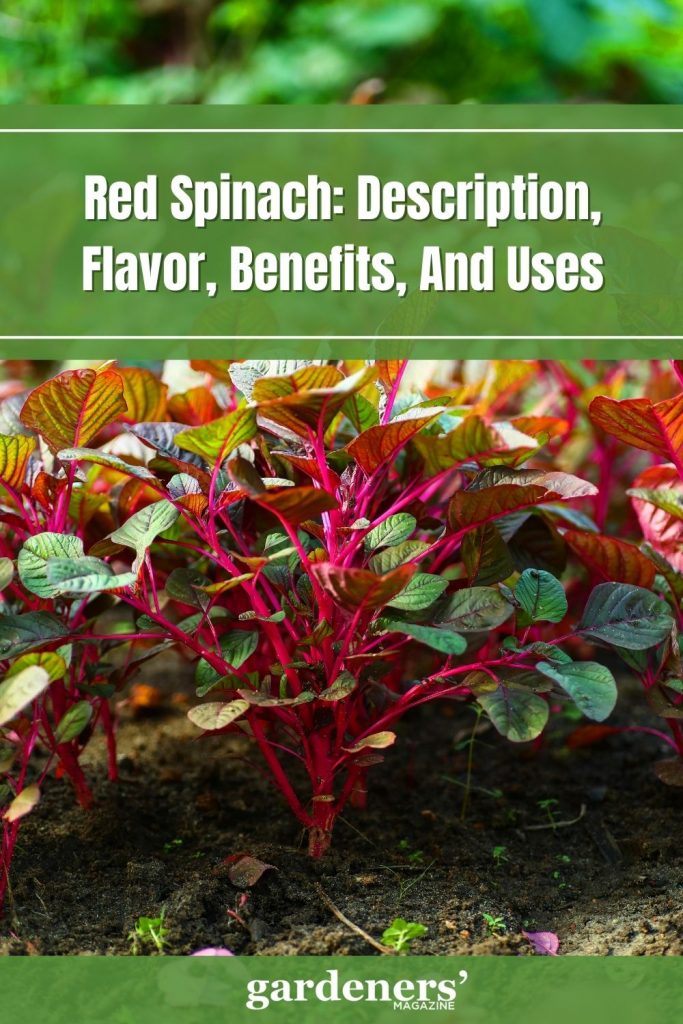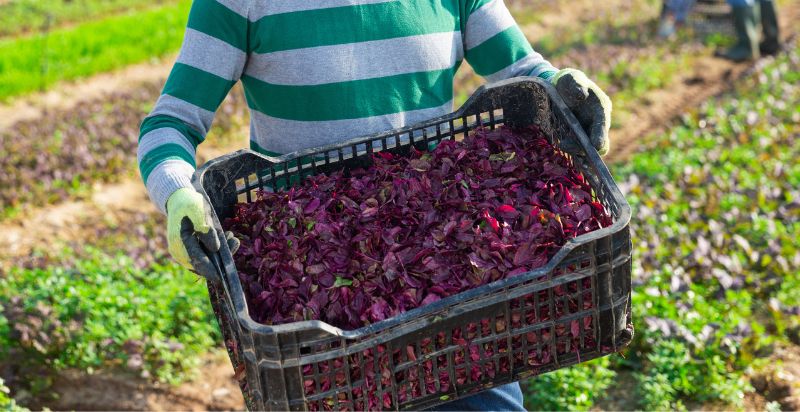Red spinach, known scientifically as Amaranthus dubius, is an edible leafy green vegetable consumed worldwide for centuries. It is believed to have originated in tropical and subtropical regions of the Americas before being spread by humans to other parts of the world. Red spinach is a member of the amaranth family and is closely related to quinoa, another popular grain-like food from South America. Here, we will discuss red spinach’s nutritional value, health benefits, and culinary uses.
What is Red Spinach?
Red spinach has been a leafy green used in traditional diets worldwide for many years. It is a member of the amaranth family and is closely related to quinoa. Red spinach looks similar to regular spinach, with large, tender leaves with a mild flavor. The leaves can range from deep red to purple and taste slightly sweet when cooked.

The History and Origin of Red Spinach:
Red spinach is a variety of the Spinacia oleracea plant, commonly known as spinach. It was first developed in the late 19th century by the German botanist Ludwig A. Koch. The plant has large, dark green leaves with a distinctive reddish hue resulting from its high levels of anthocyanin pigments, also found in other dark-colored fruits and vegetables.
Red spinach is especially popular in central Europe, commonly used for salads and soups and also consumed as juice. The popularity of red spinach has grown over the last few years due to its many benefits and its versatility in cooking. Red spinach is not the same as spinach, though the Amaranthaceae plant family includes spinach.
Health Benefits of Red Spinach:
Red spinach is a nutrient-rich vegetable that has many health benefits. It contains many essential vitamins and minerals, including iron, magnesium, calcium, zinc, and vitamin A. Red spinach is also an excellent source of dietary fiber, making it good for digestive health. Additionally, red spinach is packed with antioxidants that can help protect against certain chronic diseases, such as heart disease and cancer.
However, eating too much can have a toxic effect on the body. The high content of oxalic acid can increase the risk of developing kidney stones.
What is the Difference Between Red Spinach and Green Spinach?
Though both types of spinach belong to the Amaranth family, red spinach has higher levels of antioxidants, iron, and other nutrients than its green counterpart. It also has a lower oxalate level than green spinach.
Where are Red Spinach Grown and Harvested?
Red spinach is primarily grown and harvested in warm areas of the world. It can be found in tropical and subtropical climates, such as India, Southeast Asia, Africa, South America, Mexico, and Florida.
Red spinach grows well in hot temperatures with light morning showers or irrigation. The leaves are typically hand-harvested and then dried for preservation before being sold or used for cooking.
In some regions of the world, red spinach is also cultivated as a leafy vegetable crop that can provide a nutritious food source throughout the year.

Season and Availability of Red Spinach:
Red spinach is available throughout the year, but the peak harvests occur during the cooler months of spring and autumn.
Flavor Profile of Red Spinach:
The red spinach has a unique flavor, with hints of sweet and nutty notes. It is both slightly bitter and earthy in taste. Its texture is tender yet crunchy, making it a versatile ingredient for many dishes. The leaves are dark purple, giving any dish an intense and vibrant burst of color. The red spinach can be cooked independently or used as part of a mix in salads, soups, stews, and stir-fries.
How to Grow Red Spinach From Seeds?
Fill three-fourths of your tray with a well-composted soil and sow the seeds carefully. Space the seedlings 20cm by 15cm. Mix the seeds with some semolina or crushed rice to avoid attack from ants. The seeds usually germinate in 6 to 8 days. Transplant the seeds in 30-35 days. You can harvest the spinach 80–90 days from sowing.
Where to find the Best Quality Red Spinach?
The best red spinach can be found at local farmers’ markets or specialty grocery stores near you. You may also find it in some health food stores. When looking for the freshest and most nutrient-dense version of this leafy green, buy organic and locally sourced produce. You can also buy them at popular online stores. Interestingly, red spinach extracts are available in capsule form, but before you take any supplements, consult a physician.
Look for dark leaves with no wilted or yellowing spots and a firm stem attached. This will ensure you get the highest quality product available. Additionally, store it properly by keeping it refrigerated until ready to use and eating it as soon as possible after purchase.
How to Store Red Spinach?
Red spinach should be stored in a cool, dry place. Keep it refrigerated if possible and use it within two to three days of purchase. Rinse the leaves before storing them in an airtight container or plastic bag and make sure there is no excess moisture inside that can cause spoilage.
If you have leftover red spinach after cooking, try to eat it within a day or two, as it does not keep well for long periods. You can freeze red spinach for up to 6 months, but the texture may become mushy when thawed. For optimal freshness, consume your fresh red spinach as soon as possible.
How to Use Red Spinach in Different Recipes?
Red spinach is a tasty and nutritious vegetable that can be used in multiple dishes. It can be cooked in various ways, such as steamed, boiled, sauteed, stir-fried, or added to soups and stews.
It makes an excellent addition to salads due to its crunchy texture and mild grassy flavor. Red spinach leaves can also be cooked with garlic, onions, and tomatoes for a flavorful side dish. It pairs especially well with cheese sauces and creamy pasta.
Red spinach works great in egg dishes such as omelets, frittatas, or quiches. Mix red spinach with eggs and your favorite vegetables for an easy breakfast or brunch option for a healthy scramble or frittata.
Red spinach can also be used in pizza and wraps, giving them a nutritious boost. It can also make a delicious quesadilla when combined with cheese and beans.
Finally, red spinach makes an excellent addition to smoothies due to its high nutrient content. Try blending red spinach with other vegetables or fruits for a healthy and energizing drink. Red spinach is versatile and easy to incorporate into various recipes, making it a great choice for spicing your meals.

Can Dogs Eat Red Spinach?
Dogs can eat cooked spinach in small quantities, although raw spinach can cause gastrointestinal issues. Moderate intake can boost a dog’s immune system, whereas too much can cause kidney damage and digestion issues. So, consult your veterinarian when you are trying out a new food or are unsure what to feed your dogs.
Conclusion
Red spinach is an easy-to-find and nutritious leafy green vegetable that can be used in various dishes. It has a unique flavor profile with sweet and nutty notes and a tender yet crunchy texture. When sourcing red spinach, buy organic if possible and store it properly for optimal freshness. Red spinach can be cooked in multiple ways, used in salads, or added to smoothies for a nutritional boost. Enjoy adding this versatile vegetable to your meals!
- Everything You Wanted to Know About Red Tamarillos - June 2, 2025
- A Guide to Tulips: Everything You Need to Know & More… - June 2, 2025
- Guanabana: Description, Flavor, Benefits, And Uses - May 27, 2025

7 thoughts on “Red Spinach: Description, Flavor, Benefits, And Uses”
Comments are closed.